This exhibition was scheduled to open March 20, 2020, however, as a public health precaution, all Smithsonian museums are closed until further notice. Please check americanart.si.edu for updates!
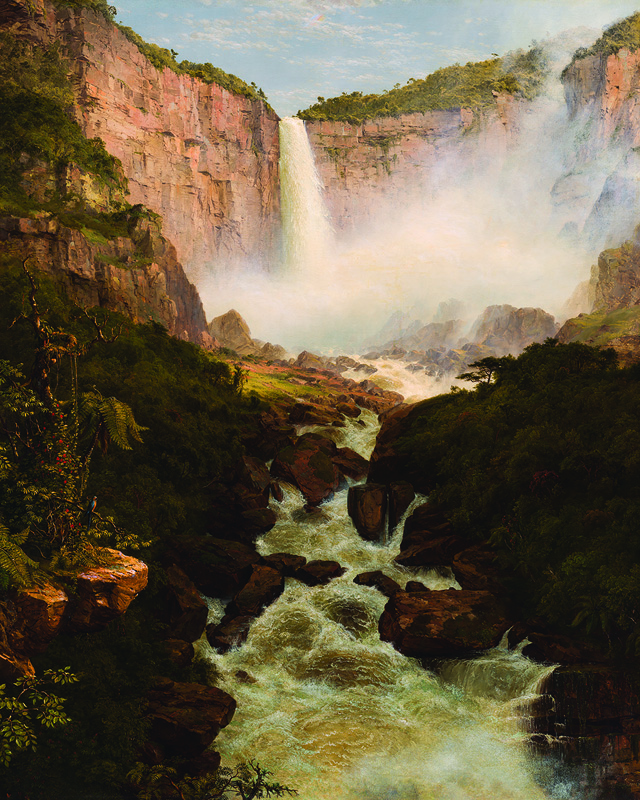
In April of 1845 Alexander von Humboldt’s first volume of Cosmos appeared in print. The response was electric, and the book became an instant best seller. All the years Humboldt spent taking notes, asking questions, exchanging and sharing specimens and ideas, and traveling—especially on a five-year journey to South America and Mexico that began in 1799 and took the German naturalist through the Amazonian jungles to the peaks of the Andes—had culminated in a comprehensive vision of the underlying natural laws governing the planet.

Cosmos attracted attention for many reasons—its unparalleled scope, its ambition, and Humboldt’s amplification of his insistent theme of the interconnectivity of everything from outer space to the bottom of the oceans and into the earth’s core. His intent, as he stated it, was to describe nature as “a unity in diversity of phenomena; a harmony, blending together all created things, however dissimilar in form and attributes; one great whole animated by the breath of life.”

The book made Humboldt an international celebrity. It extended his fame beyond the scientific institutes, the halls of academia, and the intellectual salons, and into a broad range of newspapers and literary journals. Between 1845 and his death in 1859, Humboldt published four volumes of Cosmos (the fifth was published posthumously), each well received, distributed globally, and translated into numerous languages. In America, the cumulative impact of Humboldt’s body of work so permeated cultural nationalism that it seemed sui generis—natural, obvious, and inspired by the perceived synergy between the American landscape and the American experiment. The identity of the United States was tied closely to an appreciation of nature, which had by 1845 infused the fine arts and literature in the form of the Hudson River school of painters and the transcendentalist writers. In the arena of American art, it would be landscape painter Frederic Edwin Church who most assiduously adopted aspects of a Humboldtian persona as part of his own. Church pursued the study of art and natural sciences, and he invested each of the paintings he called his “Great Pictures” with elements of Humboldt’s vision. His own travels to South America, his drive to continually reinvent the rules governing landscape painting, and the creation of his personal universe at Olana, the home he built above the Hudson River, were inflected by his exposure to Humboldt, and altogether they provide a window into understanding Humboldt’s reach at mid-century. Church would come to be hailed as “the American Humboldt.”
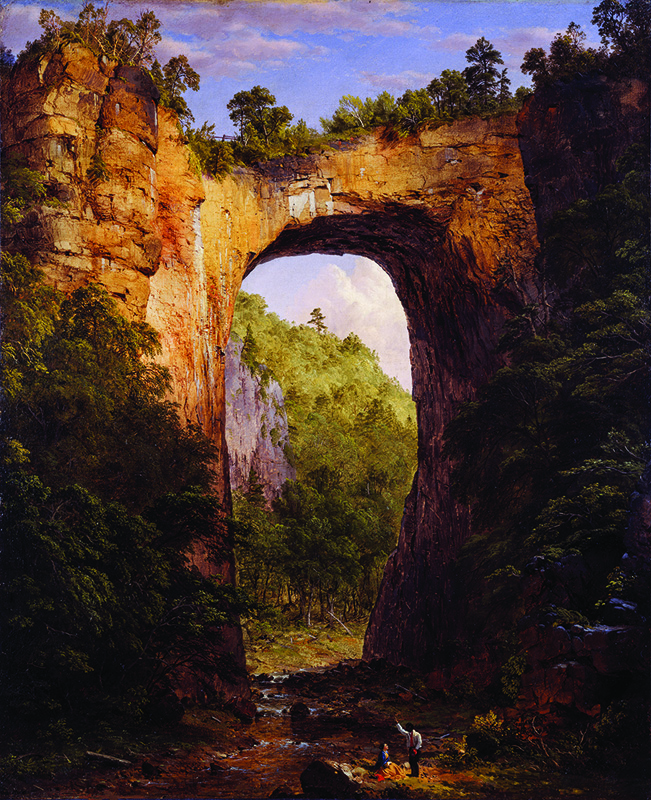
In 1845 Church was a nineteen-year-old aspiring artist whose skilled draftsmanship was coupled with a prodigious memory for color and texture. He could sketch under variable conditions in the field, then return to the studio to synthesize those immediate impressions from nature. Church came of age as Humboldt’s reputation had already made him an oft-quoted authority on numerous scientific and cultural topics. By 1849, when Humboldt’s first two volumes of Cosmos had sold more than forty thousand copies in English alone, Church had absorbed Humboldt’s ethos, and most likely he had begun to absorb his words.

Humboldt envisioned the artist as a scientist and a poet, capable of distilling the essence of nature while retaining the specific character of the local landscape. Church’s acute powers of observation were a perfect match for Humboldt’s exultation in the details in nature. And it rang true for Church that the artist should be well read in natural philosophy and observant of nature and its processes, so that he could invest his artworks with scientific truth as well as aesthetic merit. By doing so, Church pushed landscape painting to greater prominence as the genre most capable of conveying America’s cultural ambitions.

Church’s West Rock, New Haven vaulted the artist to the forefront of American landscape painting in 1849, when it was shown to great acclaim at the National Academy of Design in New York (Fig. 5). The entrepreneur Cyrus West Field, who seventeen years later organized the successful laying of the first transatlantic telegraph cable, purchased West Rock. He and Church were friends and fellow admirers of Humboldt, and the two began making long-term plans for an extended trip to South America that would follow in the naturalist’s footsteps. But first, in 1851, they took a shorter sojourn to Virginia, a trip that may have confirmed that they were amiable traveling companions.
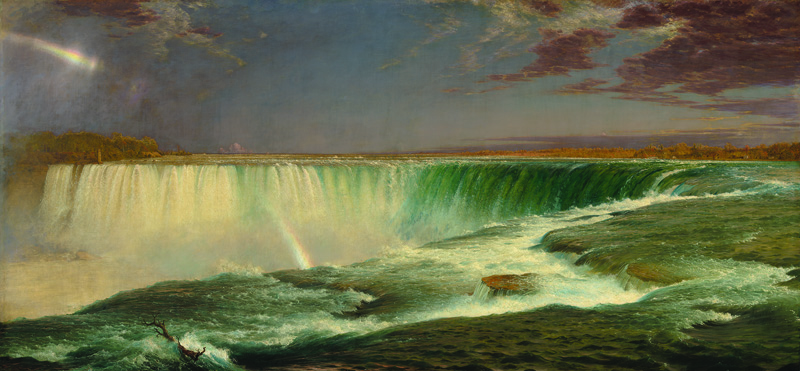
One of their stops there was the famed Natural Bridge. Thomas Jefferson had featured this geological formation in Notes on the State of Virginia (1785), which in turn had spawned decades of written, engraved, and painted descriptions of the landmark. Church and Field likely knew that Humboldt had written about it in his Views of the Cordilleras, published between 1810 and 1813.
Church sketched the arch in pencil, annotating the sheet with color notes designed to prompt his memory back in the studio. Field collected rocks that displayed the vibrant reddish hues of the stained limestone, and later offered to let Church use them as a guide. Church demurred. Field enjoyed telling the story that when he arrived to see Church’s finished Natural Bridge, Virginia, he pulled the rocks from his pockets (Fig. 4). The colors matched.
In 1853 the two men set off for South America on a journey that ultimately lasted seven and a half months. Field underwrote the cost for the trip, which they planned meticulously. They decided to concentrate on Colombia and Ecuador, following a route Humboldt had taken fifty years earlier. Their itinerary steered them inland across Colombia, following the Magdalena River toward the Andean Cordillera, where they traveled south and west along the high-altitude valley between the two parallel ridges of volcanic peaks in Ecuador. Along the way Church and Field stopped at the major landscape features Humboldt had described and illustrated in his book.
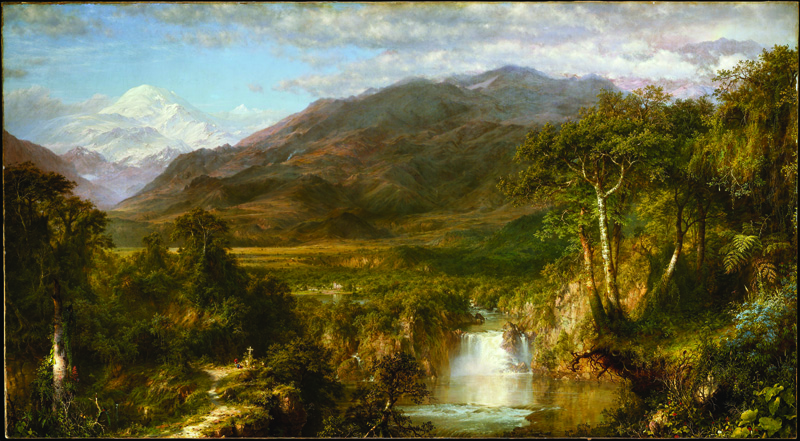
Tequendama Falls outside of Bogotá was the first scenic stop on their route. There they stayed for ten days, affording Church plenty of time to survey the waterfall, first from head-on, then from a distance, and finally from below the falls. Within a year of his return to New York, Church painted The Falls of Tequendama, near Bogotá, New Grenada, measuring five feet tall and four feet wide, capturing the roar of the torrent as it cascaded down the cliffs (Fig. 1). The painting represents the artist’s first painted homage to Humboldt.
Humboldt had described the falls in great detail. Taking his cues from him, Church trusted his instincts and training to establish his composition, adapting Humboldt’s perspective and making it his own. The Falls of Tequendama was a departure for the artist, a clear signal that he had ramped up his ambitions in keeping with the enlarged scale and unusual vertical format of the painting.
Church also went to great lengths to incorporate all the botanical, geological, and climatic information he gleaned from reading Humboldt and observing the same landscape in person.
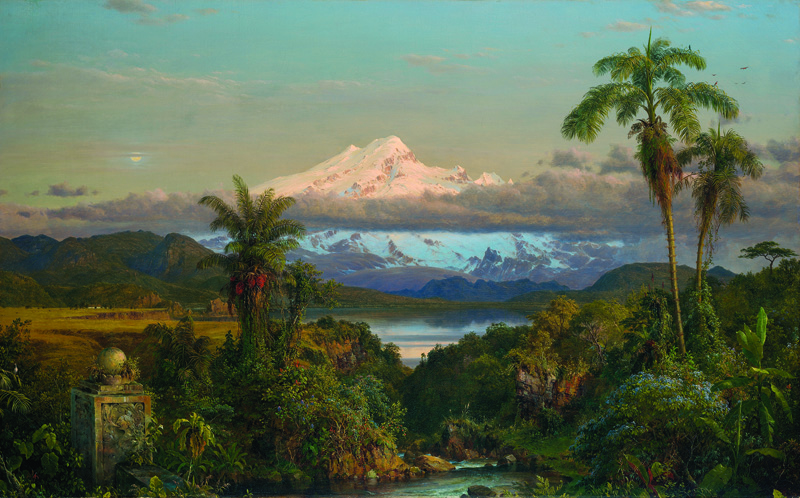
The vegetation at the bottom of the falls includes an impressive variety of tropical plants and vines, drawn with great fidelity. The curved rim, canyon walls, and the steep drop into the valley below were each rendered in sharp focus, brought together in a composition that emphasizes the vertiginous sweep of the terrain.
Back in 1853, as Church and Field crossed into Ecuador, they read from Humboldt’s travelogue. He had lavished tremendous attention on the nation’s volcanic chain of mountains, extrapolating from his observations a connection between seismic and volcanic activity and beginning to discern what would later become the theory of plate tectonics. His exuberant descriptions of smoking and rumbling volcanoes lent an air of excitement to his scientific observations. Church felt the same exhilaration. Faced with these smoking giants, he recorded their contours, climbed extensively as the weather permitted, and, not surprisingly, made these volcanoes central to his South American subjects for the rest of his career. If Humboldt had a wish for an artist who could properly capture South American scenery, Church fulfilled it in his first painting of the volcano, Cotopaxi in 1855 (Fig. 6).
That same year, Church displayed The Falls of Tequendama at the National Academy of Design. The critics marveled at the dramatic composition but were less impressed with the artist’s rendering of the turbulent water, with one acerbically noting, “He should not paint falling water—for he cannot.” Church took steps to correct that deficiency by going to Niagara Falls in 1856. His approach to understanding Niagara demonstrates the depth to which Humboldt’s influence had permeated his working method. Humboldt’s ideas—about the relevance of landscape painting, the need for a scientific rigor linked to an aesthetic sensibility, and the call for an artist capable of creating a higher style of landscape—became Church’s inspiration for focusing his own pursuits on the intersection of science and art.

Church used Niagara Falls to push beyond all established conventions of landscape painting, composing the work that would redefine his career as it announced his embrace of Humboldt’s immersive approach to understanding nature. Niagara stands out for more than its masterful rendering of moving water or the evanescent rainbow shimmering over the gorge (Fig. 7). With it, Church broke with the traditional proportions and size of an American landscape painting, and destroyed the conventional perspective accorded to views of the falls, stretching the canvas into a panoramic rectangle. He dropped out the entire foreground, suspending the viewer over moving water at the very edge of the cataract. As the reviewer in Home Journal proclaimed, “if the object of painting be to render faithfully, and yet poetically, what an artist’s eye discerns, this is Niagara, with the roar left out!”
In 1857, as Niagara began a triumphal tour across America and to London, the artist embarked on his second, shorter trip to South America. The four-month foray was intended to reacquaint Church with key features in Humboldt’s narratives, notably the explorer’s favorite volcano, the Ecuadorian peak Chimborazo. Church’s goal was to develop a suite of sketches of Chimborazo, at that point considered the highest peak on the earth, a dormant volcanic massif that had become known as “Humboldt’s mountain.” He also spent time admiring Cayambe, another extinct volcano that Humboldt considered one of the most beautiful in the Andes (Fig. 9).
Chimborazo had been socked in by low clouds during Church’s first trip, and his itinerary did not afford him time to wait for the weather to clear. This time he could stay near the mountain in hopes of sketching the summit. The drawings Church made in the field once again took in the welter of botanical detail he envisioned for the foreground of his masterpiece, Heart of the Andes (Fig. 8).
Upon his return to New York, Church let it be known publicly that he intended to outdo his earlier efforts and surpass Niagara in scale, scope, size, and attendant drama. Unlike The Falls of Tequendama, there was no optimal angle from which to compose a painting featuring Chimborazo. Instead Church composed a painting that became a summation of what he had learned from Humboldt.
Humboldt’s Naturgemälde—an annotated map or chart showing Chimborazo in cross section published in 1805—was where everything had begun. The term Naturgemälde can be inadequately translated from German (if it can be translated at all) as a “picture of nature.” But the word also implies a sense of unity or wholeness. In that map, Humboldt compressed a staggering amount of fragmentary information onto a single sheet of paper. The whole was a picture far greater than its parts: Humboldt’s Naturgemälde was a half-verbal, half-pictorial essay on all he had observed climbing from the tropical lowlands to 19,413 feet above sea level. It was a striking illustration of his central thesis that nature was a web in which everything was connected.
Heart of the Andes was Church’s extrapolation of Humboldt’s Naturgemälde. On one six-by-ten-foot canvas, the artist covered the same range of territory, incorporating the same density of detail, and invoking a similar acuity of observation. Church sketched in pencil and oil, both on-site and back in his studio, developing a body of work that provided him with the armature for his composition. Heart of the Andes required Church to draw on the totality of his accumulated sketches from nature: whether they were made in New England, at Niagara Falls, or in South America. Close observation informed his method, and Humboldt’s quest to find the common threads tying together all of creation inspired the means by which he created the largest and arguably most synthetic composition of his career.
Like Humboldt’s books, Church’s painting is a massive, overwhelming, exuberant, impassioned compendium. Heart of the Andes accounts for plants that Humboldt had collected and chronicled from the near-tropical equatorial valley floor up to the arctic summit, a span of more than ten thousand vertical feet. Church added the third dimension to Humboldt’s flattened template, allowing the viewer’s eye to float over the foreground and into the vast middle distance, across the broad plain and up the rumpled sides of the mountain chain. Chimborazo, instead of being the focal point, now became the destination, just out of reach, the most distant point in the landscape. This was not a peak to be summited so much as the capstone to a world to be understood.
The painting does not promise visual coherence. Instead it holds out the rewards of close looking and aesthetic and scientific inquiry, as well as the revelation that the mountain is the apex of an ecosystem. Its vertical progression accomplished another of Humboldt’s goals: that of extrapolating the changes in climate and habitats if one were to travel from the equator to the poles.
Church orchestrated the display of Heart of the Andes at Lyrique Hall on Broadway beginning on April 27, 1859. The colossal painting appeared even larger thanks to an elaborate frame designed to resemble a window casement; parted draperies intensified that illusion. Visitors were encouraged to bring opera glasses in order to take in the fine degree of detail in the oversized painting. He must have been pleased with the pronouncement made by one critic, who wrote:
It is seldom the fortune of any artist to achieve a triumph so complete as that accorded to Mr. Church for his fine picture of The Heart of the Andes. . . . [His] picture of Niagara has unquestionably paled before the more glowing and sentient merits of the piled up mountains of our Southern Continent. A moment’s absorbed examination, and apparently the real scene is before you—the medium of its expression disappears.6
Humboldt’s influence was widely understood and appreciated, as fellow artist Robert Walter Weir noted in a letter published in the New York Post pronouncing: “Humboldt has given us the word-painting of the magnificent scene of this picture, and now comes the true magician, with his harp of a thousand strings, to present the subtle tones that no words can describe.”7
The public response to Heart of the Andes was overwhelming. Lines formed along lower Broadway as more than five hundred people per day stood, sometimes for hours, to see this singular artistic achievement. Collector and fellow Humboldt enthusiast William T. Blodgett had arranged to purchase the painting for the unheard-of sum of $10,000, with the understanding that he could not take possession until it had completed a two-year, international tour.
Even as Church was painting Heart of the Andes, he was also planning to place it in front of Humboldt as an expression of how deeply the American artist had absorbed and could reflect the naturalist’s philosophy of nature. To accomplish this, he worked with his dealer, John McClure, who was making tentative arrangements to crate the painting and ship it to Berlin. Poet and translator Bayard Taylor, who had met and spent time with Humboldt, agreed to write a letter of introduction. Church wrote to Taylor that his “principal motive in taking the picture to Berlin is to have the satisfaction of placing before Humboldt a transcript of the scenery which delighted his eyes sixty years ago—and which he has pronounced to be the finest in the world.”8
But Humboldt died on May 6, 1859, a week after Heart of the Andes first went on public view in New York. When Church heard the news, he wrote to Taylor, “It touched me as if I had lost a friend.”9
Alexander von Humboldt and the United States: Art, Nature, and Culture is on view at the Smithsonian American Art Museum from March 20 to August 16. This article is adapted from the exhibition catalogue by Eleanor Jones Harvey, with a preface by Hans-Dieter Sues (Washington, DC: Smithsonian American Art Museum /Princeton, NJ: Princeton University Press, 2020).
1 Alexander von Humboldt, Cosmos: A Sketch of a Physical Description of the Universe, trans. E. C. Otté (London: Henry G. Bohn, 1848), vol. 1, pp. 2–3. 2 Henry T. Tuckerman, “Frederic Edwin Church,” Galaxy, vol. 1, no. 5 (July 1, 1866), p. 422. 3 Cyrus W. Field: His Life and Work [1819–1892], ed.Isabella Field Judson (New York: Harper and Brothers, 1896), p. 39. 4 “Editor’s Table: Exhibition of the National Academy of Design,” Knickerbocker, vol. 45, no. 5 (May 1855), p. 532. 5 “Our Private Correspondence,” Home Journal, vol. 9 (May 1857), p. 2; quoted and cited in Jeremy Elwell Adamson et al., Niagara: Two Centuries of Changing Attitudes, 1697–1901 (Washington, DC: Corcoran Gallery of Art, 1985), pp. 15, 76 n9. 6 “The Heart of the Andes,” Spirit of the Times, May 14, 1859, p. 157. 7 Robert Walter Weir, “Fine Arts. Church’s New Picture,” New York Post, April 20, 1859, p. 2; quoted and cited in Kevin J. Avery, Church’s Great Picture: The Heart of the Andes (New York: Metropolitan Museum of Art, 1993), pp. 37, 61 n110. 8 Church to Bayard Taylor, New York, May 9, 1859, Bayard Taylor Correspondence, Letters to Taylor, Box A –Cr., letter 1, Cornell Regional Archives, Cornell University, Ithaca, NY. 9 Church to Taylor, Hartford, June 13, 1859, ibid.
Eleanor Jones Harvey, senior curator at the Smithsonian American Art Museum, organized Alexander von Humboldt and the United States: Art, Nature, and Culture and is the author of the exhibition catalogue.
